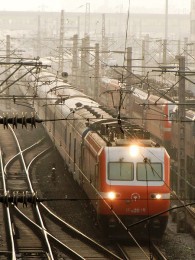“Slow Boat to China” Now A Fast Train

The hit 1948 pop song “(I’d Like To Get You On A) Slow Boat to China” now needs an update, because China has announced that it is building a fast train to America. A very fast train:
The proposed journey begins in China’s northeast and spans across Siberia to reach Bering Strait. It then crosses the Pacific Ocean by an undersea tunnel before reaching Alaska, then Canada, before finally arriving at its destination in the [continental] US. …
Running at an average speed of 350km per hour, passengers will apparently be able to complete the journey in under two days.
CROSSES THE PACIFIC OCEAN BY AN UNDERSEA TUNNEL. There is not enough punctuation in the world. I think I’ll take the slow boat, thank you.
Related: The construction of the Trans-Siberia Railroad, built with love by enemies of the state:
Still shorthanded in 1894 despite thousands of workers transported from Russia, Mezheninov requisitioned approximately 1,500 convicts from a prison near Irkutsk to fell trees and build earthworks and wooden bridges. To the relief of Mezheninov’s hard pressed engineers, even incorrigible criminals turned out to be exemplary workers, thanks to what was probably the first incentive plan in Siberia. As reward for good behaviour, the Ministry of Justice decreed that eight months’ railway labour counted as a year off a sentence. For instance, a man with four years still to serve was eligible for freedom after two years and eight months. In addition, he received a daily wage of twelve and a half cents, which in those days went a long way toward the purchase of such luxuries as tobacco and sugar, or vodka sold by the guards. Political and other noncriminal exiles were granted two years off for each year on the railway. According to an 1899 Justice study, this unprecedented magnanimity paid off handsomely: exiles and convicts worked hard and, except for fifteen who went over the hill, committed no crimes during their railway service.
And: How many people died building the Great Wall of China? 400,000. (“Many of these workers were buried within the wall itself.”)
Support The Billfold
The Billfold continues to exist thanks to support from our readers. Help us continue to do our work by making a monthly pledge on Patreon or a one-time-only contribution through PayPal.
Comments